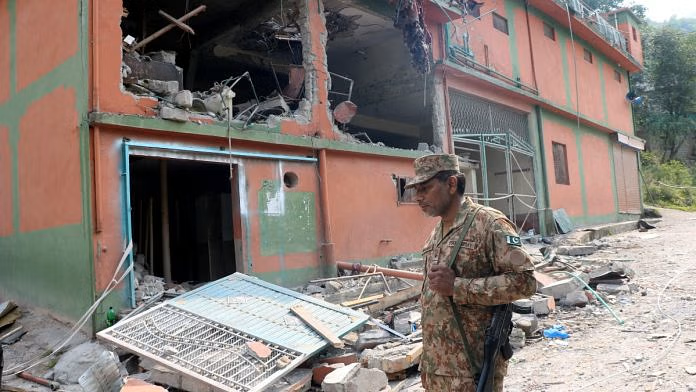This India-Pakistan escalation ladder is new and slippery
- May 22, 2025
- Posted by: Sidharth Raimedhi
- Categories: India, Pakistan

Unlike Balakot strike, recent strikes have come with undeniable evidence of mission success that Pakistan could not obfuscate. A key off-ramp from 2019 is missing this time around.
Sidharth Raimedhi
In previous crises involving an India-Pakistan escalation, there were certain assurances. Implicit assumptions, such as “someone will give in”, “someone will pick up a call”, “sense will prevail”, or that the US will mediate and help create off-ramps, generated a certain confidence that things will de-escalate. These assurances are still plausible. But they are less certain this time. Both governments will find it much harder to ‘back off’ or ‘de-escalate’. India has so far indicated that this time, the influence of restraint on its actions will be very thin.
There are two other ways in which the present escalation ladder is novel and hence untested.
First, unlike the 2019 Balakot strike, the recent strikes have come with undeniable evidence of mission success that Pakistan could not obfuscate. So, one of the main off-ramps in 2019—this inadvertent, unambiguous space for both sides to claim victory—is missing this time around.
Second, the strikes do represent a crossing of lines within the India-Pakistan playbook. Operation Sindoor’s key component is the choice of multiple targets spread across Pakistan’s geography and most crucially, Punjab—the political and military heart of Pakistan. The world now broadly expects that Pakistan will try to mirror India’s strikes and cross comparable redlines itself. The DG ISPR (Inter Services Public Relations DG) statements characterise the strike as an attack on civilian areas, also noting that India had struck the Neelum-Jhelum dam. These are plausibly moral preparations to pursue similar options against India. This makes escalation control shaky.
Third, the present crisis is also witnessing a growing interplay between two different areas of kinetic action that could take on strategic consequence in terms of escalation control. On the one hand, there is the escalation chain that is taking place in the air—missiles and drone strikes through manned and unmanned aerial platforms. Operation Sindoor is at the centre of this chain, and so will be the Pakistan response, if it comes. In the realm of perceptions, India has successfully claimed a ‘victory’ over Pakistan in this chain. In response, Pakistan is seeking to prepare and claim its own victory. This is the core of the escalation trajectory now. India’s powerful response is now sought to be matched (if not overmatched) by Pakistan.
Land-based escalation chain
There has been a heavy exchange of fire at the LoC since 23 April. First limited to small arms, this has escalated to mortars and finally, artillery. This forms an escalation chain that is more regional (sub-national), historic (more normalised than the air exchanges), as well as autonomous (both in terms of military command and dynamic). This may complicate point-scoring.
In India, there is a growing sense that the attack on civilians in Poonch by Pakistani artillery shells counts as a flagrant violation as well as a ‘retaliation’ in its own right by Pakistan. The pictures are, after all, truly horrifying, and the casualty numbers are not negligible. This does necessitate a rightful Indian response that targets military assets in the region more widely and more intensely. In turn, this could be interpreted in Pakistan as a part of Operation Sindoor—despite the fact that it may not be and given that escalations and provocations on this front have come from the Pakistani side and need to be matched.
India has attributed responsibility to Pakistan for last night’s missile and drone-led escalation, which resulted in India targeting several of Pakistan’s air defence and radar systems. Thus, India considers these strikes to be a response to Pakistan’s unjustifiable attacks on civilian areas in Poonch. However, this does not mean that the option of mirror responses near the LoC has been set aside. In this thickening fog, Pakistan has lost its ability to safely (even if broadly) anticipate future Indian actions and responses.
Meanwhile, a third potential escalation chain may start to form around the issue of water flows to Pakistan and with its own uncertain impact on the overall escalation ladder or trajectory.
This growing interplay could lead to a dynamic that further complicates de-escalation. Given that the trajectory has loosened, expanded, and become foggier, both sides will have strong incentives to win the escalation as well as prevent the larger war. Short of good luck in the form of accidental off-ramps that present themselves, the question of resolve will hence become key.
Also read: Away from LoC, General Munir is losing a far more fateful war within Pakistan
India’s resolve, a new factor
The Indian government has chosen a path of resolve. The mock drills illustrate this point. The government seeks to convey to its citizens that the high-reward option also comes with high costs, and the whole nation should be willing to bear such them, civilians included. A growing sense of national unity across political parties as well as religious communities underscores the support the government has for playing such high stakes.
The choice of crossing lines in a tense environment marked by uncertainty indicates that the Indian government is psychologically prepared to climb the escalation ladder in a way that is not similar to past examples. Past precedent could increasingly mislead. India’s willingness to accept risks and costs suggests that Pakistan has strong reasons to choose additional caution and restraint in preparing its immediate options.
Sidharth Raimedhi is a Fellow at the Council for Strategic and Defense Research (CSDR), a New Delhi-based think tank.
